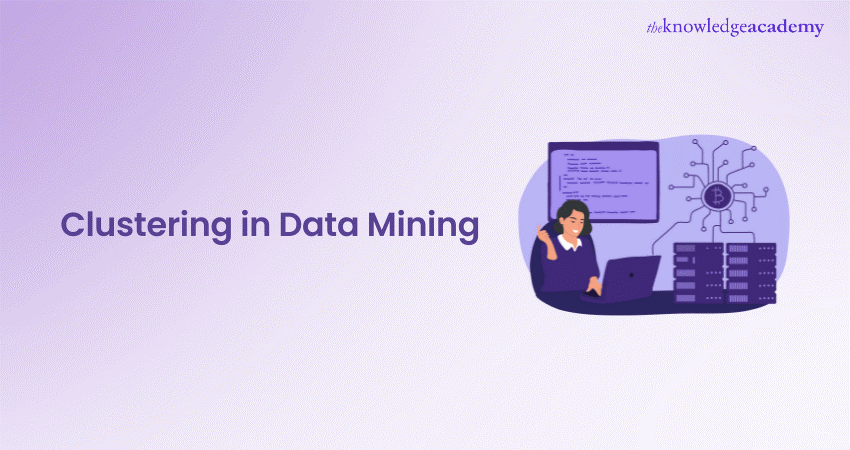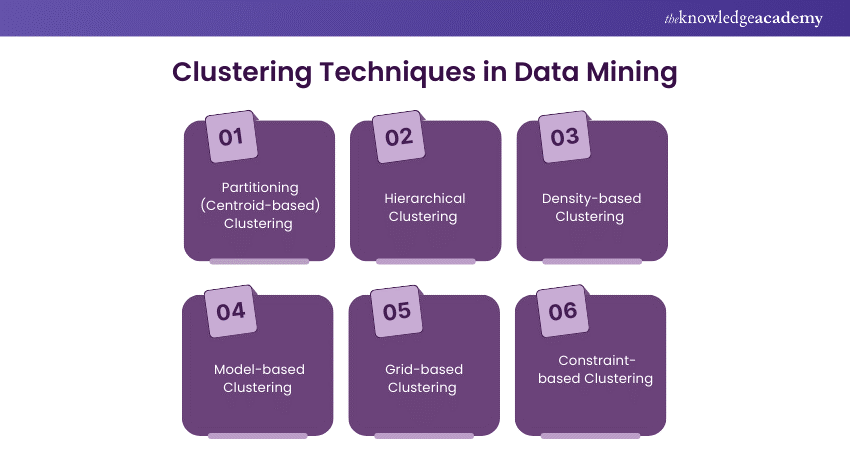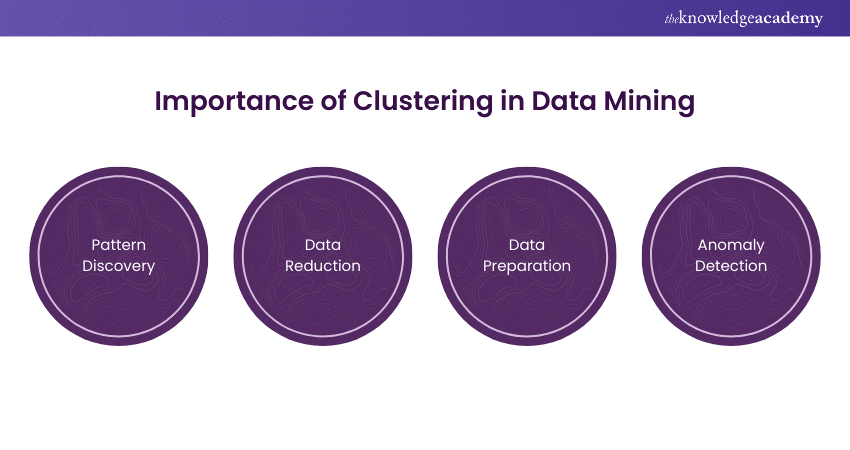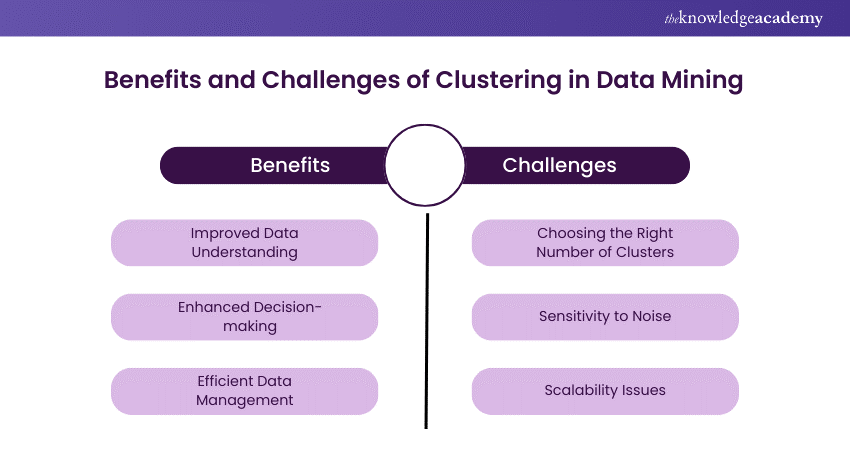We may not have the course you’re looking for. If you enquire or give us a call on +971 8000311193 and speak to our training experts, we may still be able to help with your training requirements.
Training Outcomes Within Your Budget!
We ensure quality, budget-alignment, and timely delivery by our expert instructors.

Ever felt overwhelmed by the sheer volume of data at your fingertips? Picture this: you're swimming in a vast ocean of numbers, customer profiles, and transactions. How do you find meaningful patterns amidst the chaos? Enter Clustering in Data Mining - a technique that acts like a high-tech sorting hat for your data.
From the straightforward elegance of K-means to the intricate layers of hierarchical clustering, this blog will demystify the world of clustering techniques. Join us to unlock the power of Clustering in Data Mining and transform how you analyse and use your data. Ready to unlock the full potential of your data? Dive in and discover the possibilities!
Table of Contents
1) What is a Cluster?
2) What is Clustering in Data Mining?
3) Clustering Techniques in Data Mining
4) Why is Clustering Important in Data Mining?
5) Real-world Applications of Clustering in Data Mining
6) Benefits and Limitations of Clustering in Data Mining
7) Conclusion
What is a Cluster?
A cluster is a collection of data points that are grouped together based on their similarities. Essentially, it represents a subset of data where the members of the cluster exhibit high internal similarity but are distinct from members of other clusters. This concept of grouping similar data points helps in understanding and interpreting large datasets by breaking them into manageable, meaningful sections.
What is Clustering in Data Mining?
Clustering in Data Mining is a key technique for identifying natural groupings within a dataset. It involves partitioning data into clusters so that items in the same cluster are more similar to each other than to those in other clusters. This method is crucial for Data Analysis, as it helps uncover hidden patterns, trends, and relationships that might not be immediately obvious.
By grouping similar data points together, clustering makes it easier to understand complex datasets. This approach helps derive actionable insights, aiding in decision-making and pattern recognition.
Elevate your career with our Advanced Data Science Certification Course - master cutting-edge skills and stand out in the field!
Clustering Techniques in Data Mining
Following are the clustering techniques in Data Mining, each offering a distinct approach to grouping data:

1) Partitioning (Centroid-based) Clustering
Partitioning methods involve dividing data points into a pre-defined number of clusters (k). These methods typically assume spherical clusters and aim to minimise the distance between data points and their cluster’s centroid.
K-means Clustering:
a) Description: K-means is a popular and straightforward clustering algorithm. It partitions data into K clusters, each with a centroid. Data points are linked to the closest centroid.
b) Process: It starts with randomly chosen centroids and iteratively assigns data points to the closest centroid. The centroids are recalculated until they stabilise.
c) Example: Grouping customers with similar purchasing habits in a dataset of customer purchase behaviours.
K-medoids Clustering:
a) Description: Similar to K-means, but uses the medoid (the most centrally located point) instead of the mean. Useful for categorical data where the mean might not be representative.
b) Example: Clustering data where the mean is not a good representative, such as categorical data.
2) Hierarchical Clustering
Hierarchical clustering creates a hierarchy of clusters, either by merging similar clusters (agglomerative) or splitting larger clusters (divisive).
Hierarchical Agglomerative Approach:
a) Description: Starts with each data point as its own cluster and iteratively merges the closest clusters until a single cluster remains.
b) Example: Cluster documents based on word similarity, first grouping them by general topics like sports, then into specific sports like basketball or football.
Divisive Clustering:
a) Description: A top-down approach where all data points start in one cluster, and splits are performed recursively.
b) Example: Classifying different species of plants and animals in taxonomic classifications.
3) Density-based Clustering
Density-based clustering identifies clusters based on areas of high data density, separated by sparser regions. These methods do not require pre-defined cluster shapes or numbers.
Density-based Spatial Clustering of Applications with Noise (DBSCAN):
a) Description: Forms clusters based on data point density, allowing for clusters of arbitrary shape. Defines a density threshold and a minimum number of points (midpoint's) to form a cluster.
b) Example: Clustering geological data to identify regions of high mineral concentration.
Ordering Points To Identify the Clustering Structure (OPTICS):
a) Description: An extension of DBSCAN that handles varying densities by ordering points to identify the clustering structure.
b) Example: Analysing financial transaction data with varying densities.
4) Model-based Clustering
Model-based clustering uses statistical models to represent data point distributions within each cluster, assuming an underlying model like the Gaussian Mixture Model (GMM).
Gaussian Mixture Models:
a) Description: Assumes data is generated from a mixture of Gaussian distributions. Estimates parameters (mean and variance) for each cluster’s distribution.
b) Example: Clustering customer data based on age and income to identify groups like young professionals or retirees.
Expectation-Maximisation (EM):
a) Description: Finds maximum likelihood estimates of parameters in statistical models with unobserved latent variables.
b) Example: Identifying distinct customer segments based on purchasing patterns for marketing strategies.
5) Grid-based Clustering
Grid-based clustering methods divide the data space into a grid-like structure, assigning data points to specific cells. Clustering is then performed on these grid cells rather than on individual data points.
Spatial Tingling (STING):
a) Description: STING is a grid-based clustering method that creates a multi-resolution grid structure. It analyses the density of data points within each grid cell at various resolution levels.
b) Example: Clustering image pixels based on colour. The image is subdivided into cells, and clusters of pixels with similar colours are identified within each cell.
Clustering In QUEst (CLIQUE):
a) Description: CLIQUE divides the data space into a grid structure and performs clustering on the grid cells. It is particularly useful for high-dimensional data.
b) Example: Often applied in bioinformatics for clustering gene expression data.
6) Constraint-based Clustering
Constraint-based clustering methods incorporate user-specified constraints into the clustering process. These constraints guide clustering in achieving specific goals or adhering to domain knowledge.
a) Example: Clustering social network data while ensuring a certain level of diversity within each cluster, such as including users from different age groups or professions.
COBWEB:
a) Description: COBWEB is an incremental cluster analysis system that builds a hierarchical classification of the data by arranging objects into a tree of clusters.
b) Example: Commonly used in machine learning to create concept hierarchies and understand the underlying structure of data.
Transform your Data Analysis skills with our Pandas For Data Analysis Training - learn to unlock powerful insights from your datasets!
Why is Clustering Important in Data Mining?
Clustering plays an important function in Data Mining due to its ability to simplify and organise large datasets into meaningful groups. Here’s why clustering is important:

1) Pattern Discovery: Clustering helps in uncovering hidden patterns and structures within data that can lead to new insights.
2) Data Reduction: By grouping similar data points, clustering reduces the complexity of data, making it easier to analyse and interpret.
3) Data Preparation: Clustering can be used as a preprocessing step for other algorithms, improving the performance of classification or regression tasks.
4) Anomaly Detection: Clusters can help identify outliers or anomalies by highlighting data points that do not fit well into any cluster.
Real-world Applications of Clustering in Data Mining
Clustering has numerous practical applications across various domains:
1) Customer Segmentation: Businesses use clustering to segment customers into groups based on purchasing behaviour, allowing for targeted marketing strategies.
2) Image and Text Analysis: In computer vision and Natural Language Processing, clustering helps in categorising images or texts into groups with similar features.
3) Biological Data Analysis: Clustering is used in genomics and proteomics to group genes or proteins with similar expression patterns.
4) Anomaly Detection: Clustering helps in identifying unusual patterns or outliers in security, fraud detection, and network monitoring.
Elevate your Data Analytics skills with our Advanced Data Analytics Course - equip yourself with the knowledge to excel in Big Data!
Benefits and Limitations of Clustering in Data Mining
Clustering in Data Mining offers valuable insights and efficiencies, but it also presents certain challenges. Understanding both the benefits and limitations of clustering can help in leveraging its strengths while mitigating potential drawbacks for more effective Data Analysis.

Benefits of Clustering in Data Mining
The benefits of Clustering in Data Mining include:
a) Improved Data Understanding: Clustering provides a clearer view of the data structure and relationships.
b) Enhanced Decision-making: By identifying distinct groups, clustering supports better decision-making in various applications.
c) Efficient Data Management: Clustering helps in organising and managing large datasets more effectively.
Challenges of Clustering in Data Mining
Despite its advantages, clustering has some limitations:
a) Choosing the Right Number of Clusters: Finding the optimal number of clusters can be difficult and often requires domain knowledge or trial and error.
b) Sensitivity to Noise: Some clustering methods are sensitive to noise and outliers, which can affect the quality of clustering results.
c) Scalability Issues: For very large datasets, clustering algorithms may become computationally expensive and require significant resources.
Advance your career with our Data Mining Training - gain essential skills to analyse data and extract valuable insights today!
Conclusion
Clustering in Data Mining is like finding hidden treasures in your data. By harnessing techniques like partitioning, hierarchical, density-based, and model-based clustering, you can transform complex datasets into clear, actionable insights. Embrace these methods to unlock valuable patterns and make smarter, data-driven decisions.
Unlock the secrets of Data Science with our expert-led Data Science Courses and start transforming data into actionable insights today!
Frequently Asked Questions

The goal of clustering is to group similar data points together. This enables the identification of patterns, insights, and structures within the data, often used in Data Mining and Machine Learning.

The three principles of data clustering are similarity (grouping similar data points), compactness (minimising the distance within clusters), and separation (maximising the distance between different clusters).

The Knowledge Academy takes global learning to new heights, offering over 30,000 online courses across 490+ locations in 220 countries. This expansive reach ensures accessibility and convenience for learners worldwide.
Alongside our diverse Online Course Catalogue, encompassing 19 major categories, we go the extra mile by providing a plethora of free educational Online Resources like News updates, Blogs, videos, webinars, and interview questions. Tailoring learning experiences further, professionals can maximise value with customisable Course Bundles of TKA.

The Knowledge Academy’s Knowledge Pass, a prepaid voucher, adds another layer of flexibility, allowing course bookings over a 12-month period. Join us on a journey where education knows no bounds.

The Knowledge Academy offers various Data Science Courses, including Data Mining Training, Python Data Science Course, Advanced Data Science Certification and Data Science With R Training. These courses cater to different skill levels, providing comprehensive insights into Data Mining Tools.
Our Data, Analytics & AI Blogs cover a range of topics related to Data Mining, offering valuable resources, best practices, and industry insights. Whether you are a beginner or looking to advance your Data, Analytics & AI skills, The Knowledge Academy's diverse courses and informative blogs have got you covered.
Upcoming Batches & Dates
Date








 Top Rated Course
Top Rated Course



 If you wish to make any changes to your course, please
If you wish to make any changes to your course, please


